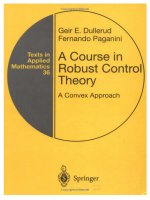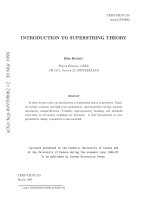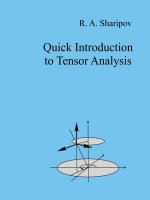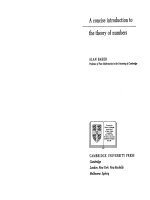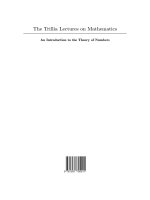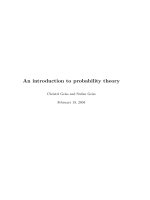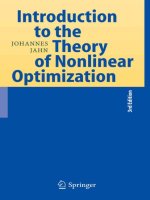A mathematical introduction to control theory
Bạn đang xem bản rút gọn của tài liệu. Xem và tải ngay bản đầy đủ của tài liệu tại đây (10.48 MB, 370 trang )
A Mathematical
Introduction to
Control Theory
SERIES IN ELECTRICAL AND COMPUTER ENGINEERING
Editor: Wai-Kai Chen (University of Illinois, Chicago, USA)
Published:
Vol. 1:
Net Theory and Its Applications
Flows in Networks
by W. K. Chen
Vol. 2:
A Mathematical Introduction to Control Theory
byS. Engelberg
S E R I E S
I N
C O M P U T E R
E L E C T R I C A L
A N D
y
Q
E N G I N E E R I N G
.
2
A Mathematical
Introduction to
Control Theory
Shlomo Engelberg
Jerusalem College of Technology, Israel
^fBt
Imperial College Pres
Published by
Imperial College Press
57 Shelton Street
Covent Garden
London WC2H 9HE
Distributed by
World Scientific Publishing Co. Pte. Ltd.
5 Toh Tuck Link, Singapore 596224
USA office: 27 Warren Street, Suite 401-402, Hackensack, NJ 07601
UK office: 57 Shelton Street, Covent Garden, London WC2H 9HE
British Library Cataloguing-in-Publication Data
A catalogue record for this book is available from the British Library.
Series in Electrical and Computer Engineering - Vol. 2
A MATHEMATICAL INTRODUCTION TO CONTROL THEORY
Copyright © 2005 by Imperial College Press
All rights reserved. This book, or parts thereof, may not be reproduced in any form or by any means,
electronic or mechanical, including photocopying, recording or any information storage and retrieval
system now known or to be invented, without written permission from the Publisher.
For photocopying of material in this volume, please pay a copying fee through the Copyright
Clearance Center, Inc., 222 Rosewood Drive, Danvers, MA 01923, USA. In this case permission to
photocopy is not required from the publisher.
MATLAB® is a trademark of The MathWorks, Inc. and is used with permission. The MathWorks does
not warrant the accuracy of the text or exercises in this book. This book's use or discussion of
MATLAB* software or related products does not constitute endorsement or sponsorship by The
MathWorks of a particular pedagogical approach or particular use of the MATLAB® software.
ISBN
1-86094-570-8
Printed in Singapore by B & JO Enterprise
Dedication
This book is dedicated to the memory of my beloved uncle
Stephen Aaron Engelberg (1940-2005)
who helped teach me how a mensch behaves
and how a person can love and appreciate learning.
May his memory be a blessing.
Preface
Control theory is largely an application of the theory of complex variables,
modern algebra, and linear algebra to engineering. The main question
that control theory answers is "given reasonable inputs, will my system
give reasonable outputs?" Much of the answer to this question is given
in the following pages. There are many books that cover control theory.
What distinguishes this book is that it provides a complete introduction
to control theory without sacrificing either the intuitive side of the subject
or mathematical rigor. This book shows how control theory fits into the
worlds of mathematics and engineering.
This book was written for students who have had at least one semester
of complex analysis and some acquaintance with ordinary differential equations. Theorems from modern algebra are quoted before use—a course
in modern algebra is not a prerequisite for this book; a single course in
complex analysis is. Additionally, to properly understand the material on
modern control a first course in linear algebra is necessary. Finally, sections 5.3 and 6.4 are a bit technical in nature; they can be skipped without
affecting the flow of the chapters in which they are contained.
In order to make this book as accessible as possible many footnotes have
been added in places where the reader's background—either in mathematics
or in engineering—may not be sufficient to understand some concept or
follow some chain of reasoning. The footnotes generally add some detail
that is not directly related to the argument being made. Additionally, there
are several footnotes that give biographical information about the people
whose names appear in these pages—often as part of the name of some
technique. We hope that these footnotes will give the reader something of
a feel for the history of control theory.
In the first seven chapters of this book classical control theory is devii
viii
A Mathematical Introduction to Control Theory
veloped. The next three chapters constitute an introduction to three important areas of control theory: nonlinear control, modern control, and the
control of hybrid systems. The final chapter contains solutions to some
of the exercises. The first seven chapters can be covered in a reasonably
paced one semester course. To cover the whole book will probably take
most students and instructors two semesters.
The first chapter of this book is an introduction to the Laplace transform, a brief introduction to the notion of stability, and a short introduction
to MATLAB. MATLAB is used throughout this book as a very fancy calculator. MATLAB allows students to avoid some of the work that would once
have had to be done by hand but which cannot be done by a person with
either the speed or the accuracy with which a computer can do the same
work.
The second chapter bridges the gap between the world of mathematics
and of engineering. In it we present transfer functions, and we discuss
how to use and manipulate block diagrams. The discussion is in sufficient
depth for the non-engineer, and is hopefully not too long for the engineering
student who may have been exposed to some of the material previously.
Next we introduce feedback systems. We describe how one calculates the
transfer function of a feedback system. We provide a number of examples of
how the overall transfer function of a system is calculated. We also discuss
the sensitivity of feedback systems to their components. We discuss the
conditions under which feedback control systems track their input. Finally
we consider the effect of the feedback connection on the way the system
deals with noise.
The next chapter is devoted to the Routh-Hurwitz Criterion. We state
and prove the Routh-Hurwitz theorem—a theorem which gives a necessary
and sufficient condition for the zeros of a real polynomial to be in the left
half plane. We provide a number of applications of the theorem to the
design of control systems.
In the fifth chapter, we cover the principle of the argument and its consequences. We start the chapter by discussing and proving the principle of
the argument. We show how it leads to a graphical method—the Nyquist
plot—for determining the stability of a system. We discuss low-pass systems, and we introduce the Bode plots and show how one can use them
to determine the stability of such systems. We discuss the gain and phase
margins and some of their limitations.
In the sixth chapter, we discuss the root locus diagram. Having covered
a large portion of the classical frequency domain techniques for analyz-
Preface
ix
ing and designing feedback systems, we turn our attention to time-domain
based approaches. We describe how one plots a root locus diagram. We
explain the mathematics behind this plot—how the properties of the plot
are simply properties of quotients of polynomials with real coefficients. We
explain how one uses a root locus plot to analyze and design feedback systems.
In the seventh chapter we describe how one designs compensators for
linear systems. Having devoted five chapters largely to the analysis of
systems, in this chapter we concentrate on how to design systems. We
discuss how one can use various types of compensators to improve the
performance of a given system. In particular, we discuss phase-lag, phaselead, lag-lead and PID (position integral derivative) controllers and how to
use them.
In the eighth chapter we discuss nonlinear systems, limit cycles, the
describing function technique, and Tsypkin's method. We show how the
describing function is a very natural, albeit not always a very good, way
of analyzing nonlinear circuits. We describe how one uses it to predict the
existence and stability of limit cycles. We point out some of the limitations
of the technique. Then we present Tsypkin's method which is an exact
method but which is only useful for predicting the existence of limit cycles
in a rather limited class of systems.
In the ninth chapter we consider modern control theory. We review
the necessary background from linear algebra, and we carefully explain
controllability and observability. Then we give necessary and sufficient
conditions for controllability and observability of single-input single-output
system. We also discuss the pole placement problem.
In the tenth chapter we consider discrete-time control theory and the
control of hybrid systems. We start with the necessary background about
the z-transform. Then we show how to analyze discrete-time system. The
role of the unit circle is described, and the bilinear transform is carefully explained. We describe how to design compensators for discrete-time systems,
and we give a brief introduction to the modified z-transform.
In the final chapter we provide solutions to selected exercises. The
solutions are generally done at sufficient length that the student will not
have to struggle too much to understand them. It is hoped that these
solutions will be used instead of going to a friend or teacher to check one's
answer. They should not be used to avoid thinking about how to go about
solving the exercise or to avoid the real work of calculating the solution. In
order to develop a good grasp of control theory, one must do problems. It
x
A Mathematical Introduction to Control Theory
is not enough to "understand" the material that has been presented; one
must experience it.
Having spent many years preparing this book and having been helped
by many people with this book, I have many people to thank. I am particularly grateful to Professors Richard G. Costello, Jonathan Goodman,
Steven Schochet, and Aryeh Weiss who each read this work, critiqued it,
and helped me improve it. I also grateful to the many anonymous referees
whose comments helped me to improve my presentation of the beautiful
results herein described.
I am happy to acknowledge Professor George Anastassiou's support.
Professor Anastassiou has both encouraged me in my efforts to have this
work published and has helped me in my search for a suitable publisher.
My officemate, Aharon Naiman, has earned my thanks many, many times;
he has helped me become more proficient in my use of LaTeX, put up with
my enthusiasms, and helped me clarify my thoughts on many points.
My wife, Yvette, and my children, Chananel, Nediva, and Oriya, have
always been supportive of my efforts; without Yvette's support this book
would not have been written. My students been kind enough to put up
with my penchant for handing out notes in English without complaining too
bitterly; their comments have helped improve this book in many ways. My
parents have, as always, been pillars of support. Without my father's love
and appreciation of mathematics and science and my mother's love of good
writing I would neither have desired to nor been suited to write a book of
this nature. Because of the support of my parents, wife, children, colleagues,
and students, writing this book has been a pleasant and meaningful as well
as an interesting and challenging experience.
Though all of the many people who have helped and supported me over
the years have made their mark on this work I, stubborn as ever, made
the final decisions as to what material to include and how to present that
material. The nicely turned phrase may well have been provided by a friend
or mentor, by a parent or colleague; the mistakes are my own.
Shlomo Engelberg
Jerusalem, Israel
Contents
vii
Preface
1.
Mathematical Preliminaries
1.1
1.2
1.3
1.4
1.5
1.6
1.7
2.
1
An Introduction to the Laplace Transform
1
Properties of the Laplace Transform
2
Finding the Inverse Laplace Transform
15
1.3.1
Some Simple Inverse Transforms
16
1.3.2
The Quadratic Denominator
18
Integro-Differential Equations
20
An Introduction to Stability
25
1.5.1
Some Preliminary Manipulations
25
1.5.2
Stability
26
1.5.3
Why We Obsess about Stability
28
1.5.4
The Tacoma Narrows Bridge—a Brief Case History 29
MATLAB
29
1.6.1
Assignments
29
1.6.2
Commands
31
Exercises
32
Transfer Functions
35
2.1
2.2
2.3
2.4
35
37
40
42
43
44
Transfer Functions
The Frequency Response of a System
Bode Plots
The Time Response of Certain "Typical" Systems . . . .
2.4.1
First Order Systems
2.4.2
Second Order Systems
xi
xii
A Mathematical Introduction to Control Theory
2.5
2.6
2.7
2.8
3.
Three Important Devices and Their Transfer Functions .
2.5.1
The Operational Amplifier (op amp)
2.5.2
The DC Motor
2.5.3
The "Simple Satellite"
Block Diagrams and How to Manipulate Them
A Final Example
Exercises
46
46
49
50
51
54
57
61
3.1
3.2
3.3
3.4
3.5
3.6
3.7
4.
Feedback—An Introduction
61
62
64
65
66
70
71
Why Feedback—A First View
Sensitivity
More about Sensitivity
A Simple Example
System Behavior at DC
Noise Rejection
Exercises
75
4.1
4.2
4.3
5.
The Routh-Hurwitz Criterion
75
84
87
Proof and Applications
A Design Example
Exercises
The Principle of the Argument and Its Consequences
5.1
5.2
5.3
5.4
5.5
5.6
5.7
5.8
5.9
5.10
5.11
5.12
5.13
5.14
More about Poles in the Right Half Plane
The Principle of the Argument
The Proof of the Principle of the Argument
How are Encirclements Measured?
First Applications to Control Theory
Systems with Low-Pass Open-Loop Transfer Functions .
MATLAB and Nyquist Plots
The Nyquist Plot and Delays
Delays and the Routh-Hurwitz Criterion
Relative Stability
The Bode Plots
An (Approximate) Connection between Frequency Specifications and Time Specification
Some More Examples
Exercises
91
91
92
93
95
98
100
106
107
Ill
113
118
119
122
126
xiii
Contents
6.
The Root Locus Diagram
131
6.1
6.2
131
133
133
134
135
138
143
6.3
6.4
6.5
7.
The Root Locus—An Introduction
Rules for Plotting the Root Locus
6.2.1
The Symmetry of the Root Locus
6.2.2
Branches on the Real Axis
6.2.3
The Asymptotic Behavior of the Branches . . .
6.2.4
Departure of Branches from the Real Axis . . .
6.2.5
A "Conservation Law"
6.2.6
The Behavior of Branches as They Leave Finite
Poles or Enter Finite Zeros
6.2.7
A Group of Poles and Zeros Near the Origin . .
Some (Semi-)Practical Examples
6.3.1
The Effect of Zeros in the Right Half-Plane . . .
6.3.2
The Effect of Three Poles at the Origin
6.3.3
The Effect of Two Poles at the Origin
6.3.4
Variations on Our Theme
6.3.5
The Effect of a Delay on the Root Locus Plot .
6.3.6
The Phase-lock Loop
6.3.7
Sounding a Cautionary Note—Pole-Zero
Cancellation
More on the Behavior of the Roots of Q(s)/K
Exercises
144
145
147
147
148
150
150
153
156
159
+ P(s) = 0 161
163
Compensation
167
7.1
7.2
7.3
7.4
7.5
7.6
7.7
167
167
168
175
180
181
188
189
189
191
193
195
196
7.8
Compensation—An Introduction
The Attenuator
Phase-Lag Compensation
Phase-Lead Compensation
Lag-lead Compensation
The PID Controller
An Extended Example
7.7.1
The Attenuator
7.7.2
The Phase-Lag Compensator
7.7.3
The Phase-Lead Compensator
7.7.4
The Lag-Lead Compensator
7.7.5
The PD Controller
Exercises
xiv
8.
A Mathematical Introduction to Control Theory
Some Nonlinear Control Theory
8.1
8.2
8.3
8.4
8.5
9.
9.12
9.13
9.14
10.
Introduction
203
The Describing Function Technique
204
8.2.1
The Describing Function Concept
204
8.2.2
Predicting Limit Cycles
207
8.2.3
The Stability of Limit Cycles
208
8.2.4
More Examples
211
8.2.4.1 A Nonlinear Oscillator
211
8.2.4.2 A Comparator with a Dead Zone
212
8.2.4.3 A Simple Quantizer
213
8.2.5
Graphical Method
214
Tsypkin's Method
216
The Tsypkin Locus and the Describing Function Technique 221
Exercises
223
An Introduction to Modern Control
9.1
9.2
9.3
9.4
9.5
9.6
9.7
9.8
9.9
9.10
9.11
203
227
Introduction
227
The State Variables Formalism
227
Solving Matrix Differential Equations
229
The Significance of the Eigenvalues of the Matrix
230
Understanding Homogeneous Matrix Differential Equations 232
Understanding Inhomogeneous Equations
233
The Cayley-Hamilton Theorem
234
Controllability
235
Pole Placement
236
Observability
237
Examples
238
9.11.1
Pole Placement
238
9.11.2
Adding an Integrator
240
9.11.3
Modern Control Using MATLAB
241
9.11.4
A System that is not Observable
242
9.11.5
A System that is neither Observable nor Controllable
244
Converting Transfer Functions to State Equations . . . . 245
Some Technical Results about Series of Matrices
246
Exercises
248
Control of Hybrid Systems
251
xv
Contents
10.1
10.2
10.3
10.4
10.5
10.6
10.7
10.8
10.9
10.10
10.11
10.12
10.13
10.14
10.15
10.16
10.17
10.18
10.19
10.20
10.21
10.22
10.23
10.24
11.
Introduction
The Definition of the Z-Transform
Some Examples
Properties of the Z-Transform
Sampled-data Systems
The Sample-and-Hold Element
The Delta Function and its Laplace Transform
The Ideal Sampler
The Zero-Order Hold
Calculating the Pulse Transfer Function
Using MATLAB to Perform the Calculations
The Transfer Function of a Discrete-Time System
Adding a Digital Compensator
Stability of Discrete-Time Systems
A Condition for Stability
The Frequency Response
A Bit about Aliasing
The Behavior of the System in the Steady-State
The Bilinear Transform
The Behavior of the Bilinear Transform as T -» 0
Digital Compensators
When Is There No Pulse Transfer Function?
An Introduction to the Modified Z-Transform
Exercises
Answers to Selected Exercises
11.1
11.2
11.3
Chapter
11.1.1
11.1.2
11.1.3
11.1.4
Chapter
11.2.1
11.2.2
11.2.3
11.2.4
Chapter
11.3.1
11.3.2
1
Problem
Problem
Problem
Problem
2
Problem
Problem
Problem
Problem
3
Problem
Problem
1
3
5
7
1
3
5
7
1
3
....
251
251
252
253
257
258
260
261
261
262
266
268
269
271
273
276
278
278
279
284
285
288
289
291
295
295
295
296
297
298
298
298
299
300
301
303
303
304
xvi
A Mathematical Introduction to Control Theory
11.3.3
11.3.4
11.4 Chapter
11.4.1
11.4.2
11.4.3
11.4.4
11.4.5
11.5 Chapter
11.5.1
11.5.2
11.5.3
11.5.4
11.5.5
11.5.6
11.6 Chapter
11.6.1
11.6.2
11.6.3
11.6.4
11.6.5
11.7 Chapter
11.7.1
11.7.2
11.7.3
11.7.4
11.7.5
11.8 Chapter
11.8.1
11.8.2
11.8.3
11.8.4
11.9 Chapter
11.9.1
11.9.2
11.10 Chapter
11.10.1
11.10.2
11.10.3
Problem 5
Problem 7
4
Problem 1
Problem 3
Problem 5
Problem 7
Problem 9
5
Problem 1
Problem 3
Problem 5
Problem 7
Problem 9
Problem 11
6
Problem 1
Problem 3
Problem 5
Problem 7
Problem 9
7
Problem 1
Problem 3
Problem 5
Problem 7
Problem 9
8
Problem 1
Problem 3
Problem 5
Problem 7
9
Problem 6
Problem 7
10
Problem 4
Problem 10
Problem 13
•
304
305
305
305
306
307
307
309
310
310
311
311
312
314
315
316
316
316
318
319
320
322
322
324
326
327
330
332
332
335
336
337
337
337
338
339
339
339
340
Contents
11.10.4 Problem 16
11.10.5 Problem 17
11.10.6 Problem 19
xvii
342
343
343
Bibliography
345
Index
347
Chapter 1
Mathematical Preliminaries
1.1
An Introduction to the Laplace Transform
Much of this chapter is devoted to describing and deriving some of the
properties of the one-sided Laplace transform. The Laplace transform is
the engineer's most important tool for analyzing the stability of linear,
time-invariant, continuous-time systems. The Laplace transform is denned
as:
£(f(t))(*)= [°°e-stf(t)dt.
Jo
We often write F(s) for the Laplace transform of f(t). It is customary to use
lower-case letters for functions of time, t, and to use the same letter—but in
its upper-case form—for the Laplace transform of the function; throughout
this book, we follow this practice.
We assume that the functions f(t) are of exponential type—that they
satisfy an inequality of the form \f(t)\ < Ceat, C € It. If the real part of s,
9ft(s), satisfies Sft(s) < —a, then the integral that defines the Laplace transform converges. The Laplace transform's usefulness comes largely from the
fact that it allows us to convert differential and integro-differential equations into algebraic equations.
We now calculate the Laplace transform of some functions. We start
with the unit step function (also known as the Heaviside 1 function):
,
/ 0t < 0
1
After Oliver Heaviside (1850-1925) who between 1880 and 1887 invented the "operational calculus" [OR]. His operational calculus was widely used in its time. The Laplace
transform that is used today is a "cousin" of Heaviside's operational calculus[Dea97].
1
2
A Mathematical Introduction to Control Theory
From the definition of the Laplace transform, we find that:
U(s) = C(u(t))(s)
e-st-ldt
= /
Jo
_ e~st °°
~s o
,. e~st
= hm
t-»oo — s
1
.
—S
Denote the real part of s by a and its imaginary part by /?. Continuing our
calculation, we find that:
Ms) = lim e'at-
1
P-j0t
t^oo
+ -
—s
S
s s
This holds as long as a > 0. In this case the first term in the limit:
e-j0t
lim e-at-
t—»oo
—s
is approaching zero while the second term—though oscillatory—is bounded.
In general, we assume that s is chosen so that integrals and limits that must
converge do. For our purposes, the region of convergence (in terms of s) of
the integral is not terribly important.
Next we consider C(eat)(s). We find that:
/•OO
£(eat)(s) = /
Jo
e(a-s)t
a-s
_
st at
e-
e dt
°°
0
1
s —a
1.2
Properties of the Laplace Transform
The first property of the Laplace transform is its linearity.
Theorem 1
£ (a/(t) + pg(t)) (s) = aF(s) + 0G(s).
3
Mathematical Preliminaries
Simply put, "the Laplace transform of a linear combination is the linear
combination of the Laplace transforms."
PROOF: Making use of the properties of the integral, we
find that:
/•OO
C (af(t) + (3g(t)) (s) = /
Jo
e-* (af(t) + (3g(t)) dt
/•OO
/>OO
= a/
e-stf{t)dt + f3
Jo
Jo
= aF{s) + 0G(s).
st
e-
g(t)dt
We see that the linearity of the Laplace transform is part
of its "inheritance" from the integral which defines it.
The Laplace Transform of sin(i) I—An Example
Following the engineering convention that j = yf-i,
we write:
sin(t) =
ejt
_
2j
e-jt
.
By linearity we find that:
£(sin(i))(s) = ^ (C(e^)(s) - r(e"'"*)(S)) .
Making use of the fact that we know what the Laplace
transform of an exponential is, we find that:
£(sin(t))(s) = —. (—
v
w ; w
2j \s-3
5—^) = -^—.
s+jj
s2 + l
The next property we consider is the property that makes the Laplace
transform transform so useful. As we shall see, it is possible to calculate
the Laplace transform of the solution of a constant-coefficient ordinary differential equation (ODE) without solving the ODE.
4
A Mathematical Introduction to Control Theory
Theorem 2 Assume that f(t) is has a well defined limit as t approaches
zero from the righf. Then we find that:
C(f'(t))(s) = sF(s) - /(0+).
PROOF: This result is proved by making use of integration
by parts. We see that:
C(f'(t))(s)= f°° e-atnt)dt.
Jo
at
Let u = e~ and dv = f'(t)dt. Then du ~ -se~st and
v = f(t). Assuming that a = TZ(s) > 0, we find that:
/ e-atf'(t)dt
Jo
=-
±e-stf(t)dt
Jo at
= s r
+ e~^f(t)\^+
e~stf(t) dt + lim e~stf(t) - /(0+)
= sF(s) + 0 - /(0 + )
= sF(s) - /(0+).
We take the limit of f(t) as t —* 0 + because the integral
itself deals only with positive values of t. Often we dispense
with the added generality that the limit from the right
gives us, and we write /(0).
We can use this theorem to find the Laplace transform of the second (or
higher) derivative of a function. To find the Laplace transform of the second
derivative of a function, one applies the theorem twice. I.e.:
C(f"(t))(s) = sC(f'(t))(s)-f'(O)
= s(sF(s)-f(0))-f'(0)
=
s2F(s)-sf'(0)-f(0).
The Laplace Transform of sin(t) II—An Example
2
The limit of f(t) as t tends to zero from the right is the value to which /(<) tends as
t approaches zero through the positive numbers. In many cases, we assume that f(t) = 0
for t < 0. Sometimes there is a jump in the value of the function at t = 0. As the zero
value for t < 0 is often something we do not want to relate to, we sometimes consider
only the limit from the right. The limit as one approaches a number, a, from the right
is denoted by a+. By convention /(0+) = lim t _ >0+ f(t). Of course, if f(t) is continuous
at 0, then /(0+) = /(0).
5
Mathematical Preliminaries
We now calculate the Laplace transform of sin(t) a second way. Let f(t) = sin(t). Note that f"(t) = -f(t) and
that /(0) = 0, /'(0) = 1. We find that:
£(-sin(£))(s) = s2£(sin(i))(s) - sO - 1 *>
-£(sin(t))(s) = s2£(sin(t))(s) - 1 <>
s
2
O + l)Ê(sin(f))(s) = 1 ô*ã
Ê(sin(*))(s) =
^
.
The Laplace Transform of cos(i)—An Example
From the fact that cos(t) = (sin(i))' and that sin(0) =
0, we see that:
C(cos(t))(s) = sC(sm(t))(s) - 0 =
-£-.
An easy corollary of Theorem 2 is:
Corollary 3
£ (/„* f(y) dy) (s) = %&.
PROOF: Let g(t) = /0* f(y) dy. Clearly, g(0) = 0, and
g'(t) = f(t). From Theorem 2 we see that C(g'(t))(s) =
sC(g(t))(s) - 0 = £(/(*))(*)• We find that £(J* f(y) dy) =
F(s)/s.
We have seen how to calculate the transform of the derivative of a
function; the transform of the derivative is s times the transform of the
original function less a constant. We now show that the derivative of the
transform of a function is the transform of — t times the original function.
By linearity this is identical to:
Theorem 4
6
A Mathematical Introduction to Control Theory
PROOF:
= - r (-*/(*)) dt
Jo
= C(tf(t)).
The Transforms of tsin(t) and te~t—An Example
Using Theorem 4, we find that:
Similarly, we find that:
c{te t] =
~
~Ts ( T + I )
=
(J+ip-
VFe see i/iai i/iere is a connection between transforms whose
denominators have repeated roots and functions that have
been multiplied by powers oft.
As many equations have solutions of the form y(t) = e~atf(t), it will
prove useful to know how to calculate £ (e~atf(t)). We find that:
Theorem 5
£{e-atf(t))(s) = F(s + a).
PROOF:
C{e-atf{t)){s)=
[°°e-ste-atf(t)dt
Jo
/•OO
= /
e-(s+a)tf(t)dt
Jo
= F{s + a).
The Laplace Transform of te~* sin(i)—An Example
